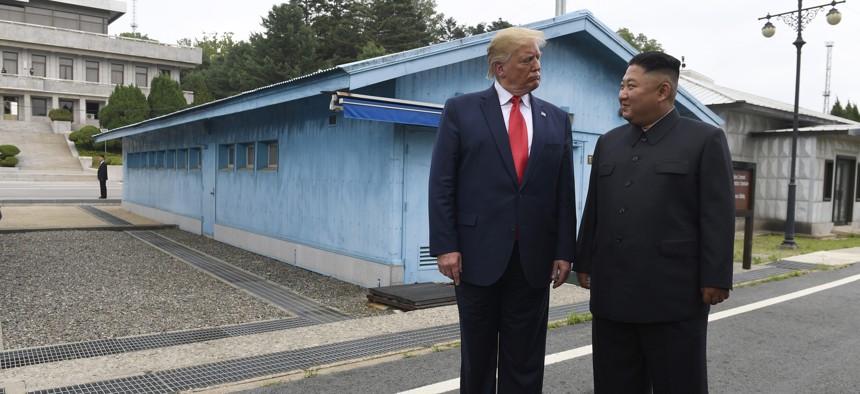
President Donald Trump meets with North Korean leader Kim Jong Un at the border village of Panmunjom in Demilitarized Zone, South Korea. AP Photo/Susan Walsh
The Normalization of Meeting Kim Jong Un
Trump probably won’t convince the North Koreans to give up their nuclear weapons. But that doesn’t mean he has accomplished nothing.
It all started, as it often does these days, with a tweet from President Donald Trump: “I will be leaving Japan for South Korea (with President Moon). While there, if Chairman Kim of North Korea sees this, I would meet him at the Border/DMZ just to shake his hand and say Hello(?)!” Thirty-two hours later, Trump shook hands with the North Korean leader, Kim Jong Un, and became the first sitting American president to step into North Korea.
It wasn’t always this way.
For decades, American or South Korean officials hoping to speak with North Korean officials have faced a drawn-out, frustrating process. There are telephones, for example, on either side of the Joint Security Area between North and South Korea, but the North Koreans would rarely pick up. So when United States and South Korean officials in the area needed to send a message to North Korea, they would place a call to their counterparts even though they knew it was a lost cause, walk up to the border and kindly request to no one in particular that they answer the phone, call again without success, and then return to the border, where this time they would encounter a few North Korean soldiers with a handheld camera to record the message as it was read aloud. This happened dozens of times a year. Quite recently. “It’s very convoluted,” one UN official admitted to me as I headed to the demilitarized zone in 2018.
Now the president of the United States simply tweets at Kim (who “follows” him on Twitter, naturally) that, hey, he’s swinging through town and would love to meet up! And the next day, with the kind of spontaneity that was surely made possible by intensive staff work, the two men actually do, shaking hands in the Joint Security Area that for the past 66 years has embodied the unresolved hostilities of the Korean War.
The way things are going, Trump probably won’t be the president who finally convinces the North Koreans to give up their nuclear weapons. Pyongyang’s arsenal remains as formidable today as it was when Trump and Kim held their first summit one year ago, despite North Korea’s suspension of nuclear and long-range missile tests. But that doesn’t mean Trump has accomplished nothing. What Sunday’s meeting in the demilitarized zone highlighted is that the president has shattered the American taboo of meeting with the head of the Kim regime and established a top-level channel of communication between decades-old enemies—to the point where such a dialogue doesn’t only have ample precedent but is commonplace, even casual. For better or worse, it’s a real legacy.
Crossing the Military Demarcation Line dividing the Koreas, Trump greeted Kim at the iconic row of blue conference buildings. As they huddled at the Freedom House on the southern side of the border, Trump and Kim paid tribute to their “excellent relations” and the “historic moment.”
While Trump’s diplomatic engagement with Kim has produced many firsts and many moments, it has yet to yield any real progress on the core issue of North Korea’s nuclear-weapons program, including long-range missiles that are potentially capable of delivering nuclear warheads to the United States.
The president has conducted nuclear talks with Kim as though they were a reality-TV show, while often ignoring or distorting the grave underlying realities of the negotiations. Standing at Observation Point Ouellette along the DMZ on Sunday, he declared that “all of the danger went away” after his initial summit with Kim in Singapore, when nothing’s changed in terms of North Korea’s military capabilities. (The military tensions that threatened to devolve into another war on the Korean peninsula in 2017 have undoubtedly subsided, for now at least.)
Trump similarly stated at a press conference before his trip to the DMZ that Barack Obama was “begging for a meeting” with Kim but that the North Korean leader had refused his predecessor’s requests. When I asked Ben Rhodes, one of Obama’s top foreign-policy advisers, whether this was in fact the case, he responded, “No. Not at all. Never.”
The most substantive outcome from the quickie summit appears to be breathing new life into working-level negotiations that had been dormant since February, when Trump and Kim’s second summit in Vietnam collapsed over disputes on how to sequence denuclearization and sanctions relief. In seeking to revive the diplomacy, Trump redefined the purpose of presidential visits to the DMZ, which have always been about theatrics and photo ops but were traditionally intended to signal steely determination to a hostile North Korea. In the throes of the Cold War, Ronald Reagan proclaimed that he was standing at the front line between the free world and its antithesis. Bill Clinton threatened to “end” North Korea if it ever used nuclear weapons. George W. Bush came to the border shortly after he included North Korea in his “axis of evil,” and Obama arrived as the United States sought to dissuade Pyongyang from launching a long-range rocket. Trump’s own vice president, Mike Pence, deliberately walked outside during a visit to the Joint Security Area in 2017 because he wanted the North Koreans to “see our resolve in my face.” This was not Trump’s message on Sunday. “Stood on the soil of North Korea, an important statement for all, and a great honor!” he tweeted as he departed South Korea.
Earlier, after meeting with Kim, Trump said: “We are going to have teams, they are going to meet over the next weeks, they are going to start a process.” Joseph Yun, who served as the North Korea envoy for Obama and Trump from 2016 to 2018, recently told me that he thinks this “process” might ultimately prove to be the “only thing Trump accomplished [on North Korea] in his first term.”
The question is whether that process is sustainable, given that Kim has made clear that his preference is to deal only with the president rather than his more hard-line advisers, let alone any future Democratic president bent on repudiating Trump’s record on foreign policy.
Trump’s Democratic challengers in 2020 have denounced the president for cozying up to North Korea’s dictator and getting nothing in return, but not necessarily for his decision to negotiate directly with Kim. Republicans, who once hammered Obama for saying he would meet with the leaders of adversarial governments without preconditions, have largely been rendered mute on the issue now that the leader of their party has taken that tack with such gusto.
If Trump fails to denuclearize North Korea during his time in office, the leader-to-leader channel could provide an avenue for avoiding conflict with a nuclear-armed North Korea.
Even Trump, however, seems to recognize that the most concrete result of all his summitry, displayed to such dazzling effect on Sunday, may not be as durable as it seems. “We have a very good relationship,” Trump said of Kim just ahead of their meeting. “I don’t know about beyond the two of us, but I can say the two of us.”




